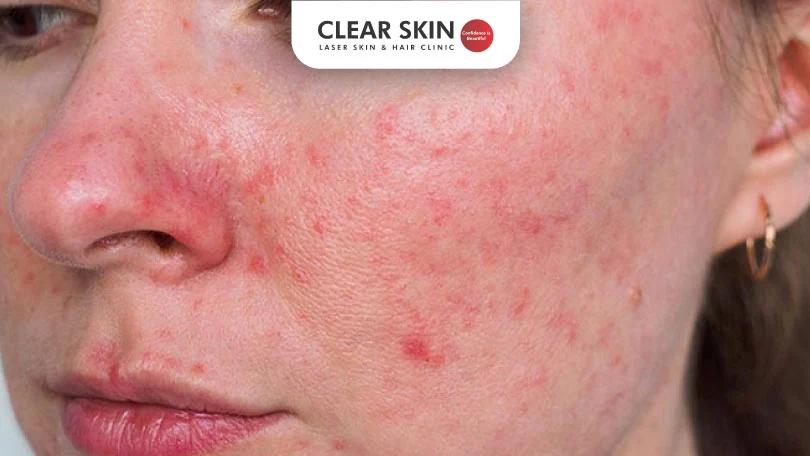Red Acne Marks: Causes, Treatments, and Prevention
Reviewed By:![]() Dr. Dhanraj Chavan
Dr. Dhanraj Chavan
Updated on: 13th September, 2024

Acne can be a frustrating skin condition, not just for teenagers but for adults as well. One of the lingering effects of acne is the presence of red marks on the skin. These red acne marks, medically known as post-inflammatory erythema, can be as bothersome as the acne itself. In this article, we will delve into what causes these red marks, how they differ from other types of acne scars, and explore effective treatment methods, both at home and in clinical settings.
Table Of Content
- What Are Red Acne Marks?
- Causes of Red Acne Marks
- Home Remedies for Red Acne Marks
- Topical Treatments for Red Acne Marks
- Professional Treatments for Red Acne Marks
- Prevention Tips
- Conclusion
What Are Red Acne Marks?
Red acne marks are the result of inflammation that occurs after an acne breakout. When acne appears, the skin becomes inflamed, and if the pimples are popped or broken, the inflammation can worsen. This leads to the dilation and sometimes damage of blood vessels, resulting in red marks on the skin. Unlike pigmented acne scars that are darker or lighter in color, red acne marks are specifically caused by the vascular response to inflammation
Causes of Red Acne Marks
The primary cause of red acne marks is inflammation. During an acne breakout, the skin’s blood vessels increase in number and size to fight the inflammation. Popping pimples can exacerbate this, leading to damaged blood vessels and subsequent redness. It is crucial to differentiate these marks from post-inflammatory hyperpigmentation, which involves pigment changes in the skin.
Home Remedies for Red Acne Marks
- Gentle Cleansing: Use a mild, non-irritating cleanser. Harsh soaps can aggravate inflammation, making the redness worse.
- Moisturizing: Keep your skin well-hydrated with a gel-based moisturizer. Proper hydration helps maintain skin quality and reduces the risk of excessive oil production.
- Sun Protection: Apply a non-comedogenic sunscreen to protect inflamed skin from sun exposure, which can worsen pigmentation.
- Mild Exfoliation: Use gentle exfoliants once or twice a week to remove dead skin cells and promote new skin growth.
Topical Treatments for Red Acne Marks
- Azelaic Acid: An anti-inflammatory that also helps reduce pigmentation and accelerates skin cell turnover.
- Niacinamide: Known for its anti-inflammatory properties, it reduces inflammation and regulates oil production.
- Vitamin C: An antioxidant that helps create new collagen and reduce pigmentation. It also combats oxidative stress in the skin.
- Retinoids: Promote skin cell turnover and reduce oil production, helping to fade red marks over time.
Professional Treatments for Red Acne Marks
If home remedies and topical treatments do not suffice, consider professional treatments:
Chemical Peels:
These increase cell turnover and reduce oil production, helping to control inflammation.
Laser Therapy:
Targeting blood vessels, lasers reduce inflammation and redness. Treatments like pulsed dye lasers or intense pulsed light (IPL) can minimize redness effectively.
Prevention Tips
Preventing red acne marks involves early treatment of acne and avoiding pimple popping. Early intervention reduces inflammation, while avoiding popping prevents worsening of red marks. Consult a dermatologist in Pune for tailored advice and treatment plans based on acne severity.
Do You Know?
Roughly 250 Patients Are Treated
Everyday By These Dermatologists
(You are one click away from flawless skin)
Meet Our Dermatologist!
Conclusion
Red acne marks can be managed effectively with a combination of home care, topical treatments, and professional interventions. Understanding the nature of these marks and addressing them promptly can prevent long-term skin issues. Remember, patience and consistency are key to achieving clearer skin. For severe cases, seek professional guidance to ensure the best outcome for your skin health.
Thank you for reading, and stay tuned for more insightful articles on skin health!
Further Reading
10 Common Skincare Mistakes You Might Be Making and How to Avoid Them
Discover 10 common skincare mistakes that could harm your skin, from over-cleansing to skipping sunscreen.
Top Treatments for Acne Scars
Discover top treatments for acne scars, from pigmentation solutions to advanced procedures for deep scars.
How to Remove Pigmentation from Face?
How to Remove Pigmentation from Face? Learn effective ways to treat facial pigmentation, from chemical peels to laser therapy.
Top 5 Safe and Effective Hair Removal Methods
In this blog, we will explore the Top 5 Safe and Effective Hair Removal Methods available and help you determine which one is the safest and best suited for your skin.
Have thoughts? Please let us know
We are committed not only to treating you, but also educating you.






